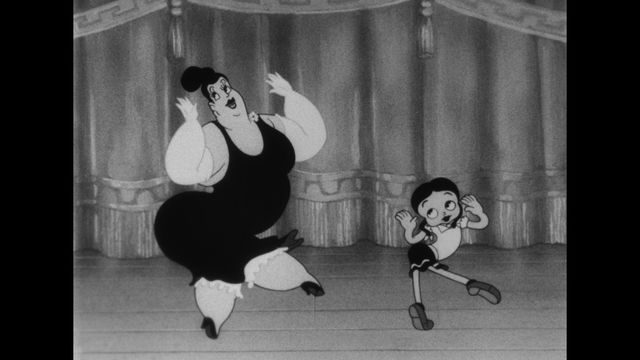
Buzzy Boop at the Concert / Inner Sanctum
- This is a past program
Part of the UCLA Film & Television Archive’s 2022 UCLA Festival of Preservation screening series. Register at cinema.ucla.edu to attend this in-theater screening.
Buzzy Boop at the Concert
U.S., 1938
Eight years after Betty Boop first appeared on-screen to become an era-defining animated icon, the Fleischer Brothers extended her on-screen family with the intention of freshening up the brand. Introduced in 1938 as Betty’s country cousin, Buzzy Boop was Betty’s comic opposite in every way. Where Betty was frequently the fetching victim of unwanted mischievousness, the gum-smacking, marble-shooting, pig-tailed dynamo Buzzy initiated chaos wherever she went. Unseen for 85 years, Buzzy Boop at the Concert is one of only two shorts she appeared in and was thought lost until a print was discovered in Russia in 2019.
DCP, b&w, 8 min. Production: Fleischer Studios. Distribution: Paramount Pictures. Producer: Max Fleischer. Director: Dave Fleischer. With: Mae Questel, Jack Mercer.
Restoration funding provided by ASIFA-Hollywood. Restored by the UCLA Film & Television Archive. Laboratory services by Roundabout Entertainment, Inc., Audio Mechanics, DJ Audio, Inc., FotoKem. Special thanks to Gosfilmofond, Stanislav Dedinsky, Natalie Ryabchikova, Paramount Pictures Archives.
Inner Sanctum
U.S., 1948
Interior, train compartment, night. A refined woman (film and television actress Eve Miller) meets an older man (Fritz Leiber Sr.) who displays an uncanny ability for predicting the near future. As they approach their destination, he begins to share a tale about the next stop along the route. Cut to Harold Dunlap (Charles Russell), a mysterious man-from-nowhere, murdering a woman on the station’s platform. After dumping her body on the back of the train, he discovers a young rail buff has witnessed his crime. A series of events lead Dunlap to a boarding house where—surprise!—the young train enthusiast also lives, leading to a tangled web of side-eyes and lies, and a devious noir-tinged twist.
What began as a series of mysteries first published by Simon & Schuster in 1930, the Inner Sanctum strand evolved into a radio program that first hit the airwaves in 1941 and spanned over 500 episodes through the fall of 1952, most of which are now considered lost. Embedded within the property’s broadcast run was the production of seven features bearing the Inner Sanctum identifier, first as a six-film series starring Lon Chaney Jr. produced by Universal between 1943-1945 and, finally, as Inner Sanctum (1948), the sole feature film produced by production company M.R.S. Pictures, Inc. Star Charles Russell, who had a small career with Columbia and 20th Century Fox and in independent productions before pivoting to a brief stint in radio in the late 1940s, plays Dunlap with the menace and threat appropriate for a noir sociopath. Prolific director Lew Landers brings his experience working outside of the studio system to this low-budget production and makes the most of the boarding room’s layout, stark lighting and dense scenic design to give this chapter its appropriately mysterious and ominous air. Pleasant dreeeeaaams, hmmmm?
—K.J. Relth-Miller
35mm, b&w, 62 min. Production: M.R.S. Pictures, Inc. Distribution: Film Classics, Inc. Producers: Samuel Rheiner, Walter Shenson. Director: Lew Landers. Based on the Inner Sanctum Mystery radio series created by Himan Brown. Screenwriter: Jerome Todd Gollard. Cinematographer: Allen G. Siegler. With: Charles Russell, Mary Beth Hughes, Billy House, Dale Belding, Fritz Leiber.
Restored by The Packard Humanities Institute in The PHI Stoa Film Lab.


